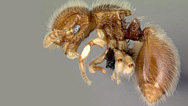Carnivorous Plants, Killer Ants
- By Anna Rothschild
- Posted 10.03.13
- NOVA
These flesh-eating plants usually prey on unsuspecting insects. But one species of ant calls this plant home. Watch the drama unfold through watercolor animation.
Transcript
Carnivorous Plants and Killer Ants
Posted: October 3, 2013
This is the tale of two unlikely conspirators: a carnivorous plant and a killer ant.
The carnivorous fanged pitcher plant, Nepenthes bicalcarata, lives in the peat swamp forests of Borneo. Its red and green leaves curve into pitcher-shaped receptacles filled with acidic digestive juices. They secrete a sweet nectar, which small insects are attracted to. But, like many pitcher plants, the rim of this pitcher gets slippery when wet, causing the unlucky bugs to fall in and drown. That’s when the digestive juices go to work, breaking down the bugs within a couple of days.
But this pitcher plant has a problem. Its digestive fluids are only mildly acidic, and mosquitoes and certain flies find that it’s the perfect place to lay their eggs. The larvae that emerge eat some of the drowned bugs. These larvae are what’re called “kleptoparasites” because they steal the nutrients that would otherwise be absorbed by the plant.
That’s where the ant Camponotus schmitzi comes in. This ant lives out almost its entire life on the fanged pitcher plant. Not only has it evolved to walk on the pitcher’s slippery rim to get at the nectar, it can even swim in the plant’s digestive juices, eating some of the other insects floating in the acidic bath. For years, scientists thought these ants were also parasites. But recently researchers have discovered that, far from harming the plant, these ants help it.
Here’s what happens: the swimming ants dive into the liquid, grab the parasitic pupae or larvae, forcibly drag them out of the pitcher, and eat them. This keeps the larvae from stealing nutrients from the plant. It also allows the plant to gain extra nutrients, since Camponotus schmitzi lives on the plant, and inevitably uses the pitcher like a toilet. And because of all the bugs and baby mosquitoes, this ant’s poops are pretty nutrient rich. On top of that, when the ants die, their carcasses often fall into the pitcher and are consumed as well.
In the end, the ants get food and shelter, and the plants get additional nutrients and protection from maggot-y thieves. It’s a pretty good deal, but it’s not one that I plan to take advantage of anytime soon.
Ew.
Credits
PRODUCTION CREDITS
- Producer, Editor, Animator
- Anna Rothschild
- Host
- Anna Rothschild
- Production Help
- Alison Bruzek
- Original Footage
- © WGBH Educational Foundation 2013
MEDIA CREDITS
- (A Novel Type of Nutritional Ant–Plant Interaction: Ant Partners of Carnivorous Pitcher Plants Prevent Nutrient Export by Dipteran Pitcher Infauna. Video_S1.avi. Mathias Scharmann Daniel G. Thornham T. Ulmar Grafe. Walter Federle. PLOS One. 2013)
- Figshare/CC-BY
- (ID-map-borneo)
- Wikimedia Commons/Public Domain
IMAGE
- (main image: ant on pitcher plant)
- © WGBH Educational Foundation 2013
Related Links
-

Making More Stuff
Host David Pogue hits the road to explore the frontiers of invention and innovation.
-

Plants with Family Values
Scientists find that plants can act altruistically toward their siblings.
-

Lord of the Ants
Naturalist E.O. Wilson's fascination with little creatures has led him to some very big ideas.
-

The World Ant Tour
American scientists visit European museums to photograph ants in exquisite detail.

